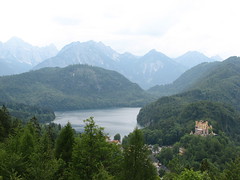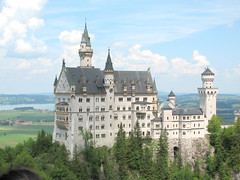Poor Ludwig II of Bavaria, a king that should have born in the middle ages, or better, inside the pages of some fairy tale; but instead presided over the loss of Bavaria’s sovereignty and the assimilation of his alpine wonderland into the decidedly less romantic Prussian empire.
This Saturday we drove with T & K from München down into the Alps, to visit Ludwig’s Neuschwanstein, a castle poised white and glittering on steep hills over an alpine lake, very obviously the model for Disneyland’s Sleeping Beauty castle. Ludwig comissioned this towards the end of his life, after being forced first to hand over control of his army to the Prussians, and finally to merge Bavaria itself into the Kaiser’s empire after Bismark’s defeat of France.
But Ludwig had already long since made clear where his aesthetic and emotional sympathies lay: He was obsessed with Wagnerian opera, a patron of Wagner himself, who was installed in München until he began grating on the locals. The young king broke off a marriage that frightened him, vacillated over the political dismantling of his once-proud Catholic state being forced on him from the Protestant north, and finally retreated to his Alpine territories to build castles that were utterly anachronistic, modeled not even on historical royal dwellings but on the romantic notions of them.
Neuschwanstein itself wasn’t finished before Ludwig drowned (crazy, depressed, or murdered, stories of all three exist); but even in its unfinished state it is spectacular enough to seem exactly what Ludwig meant it as: a piece of timeless fantasy, and an escape from the gathering darkness in German, and world history.

